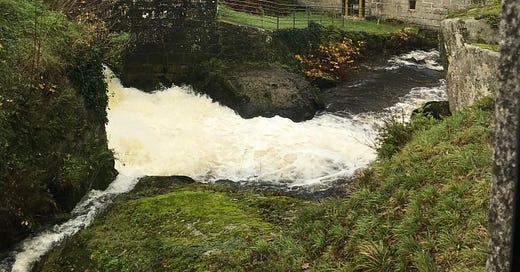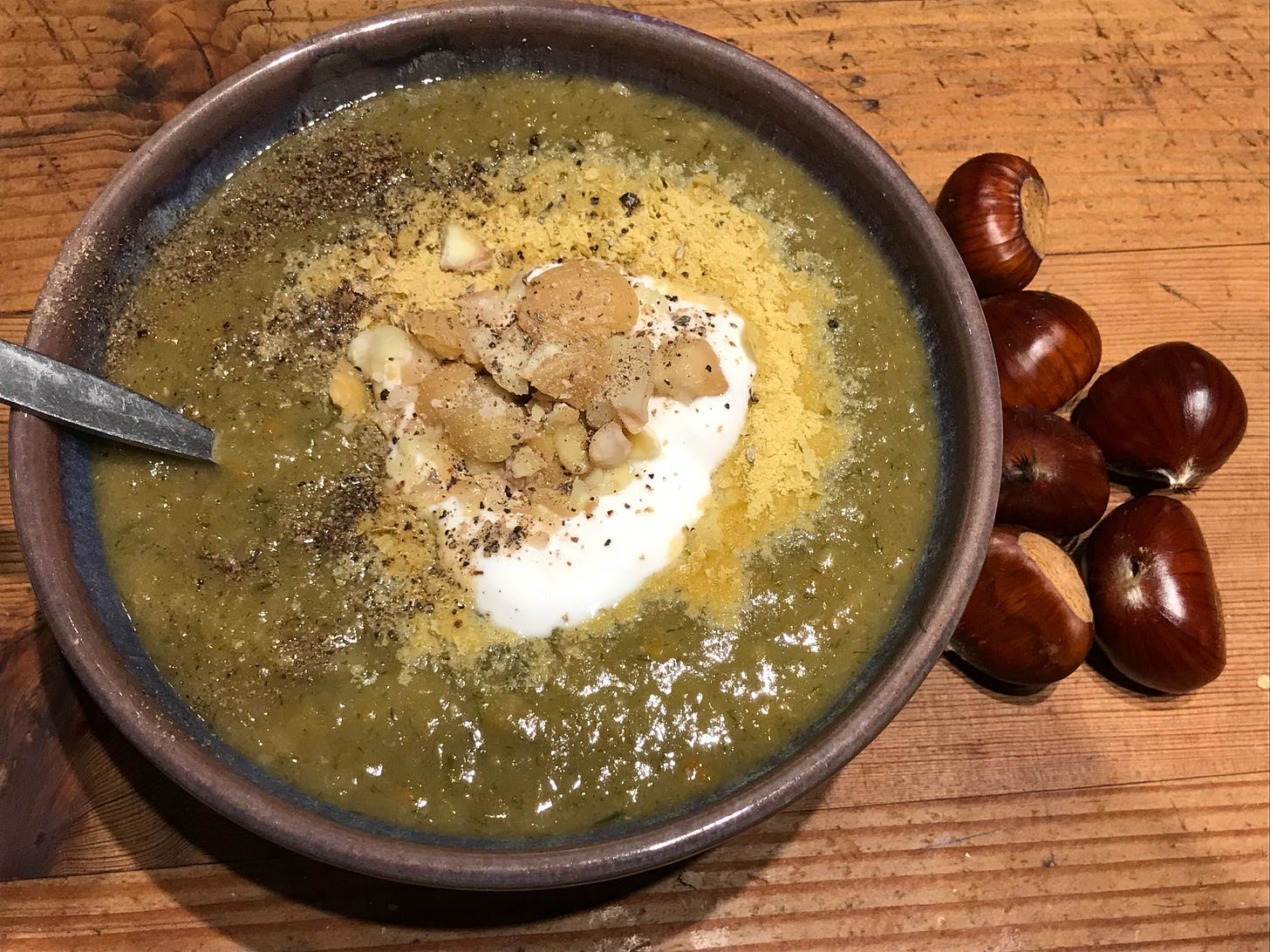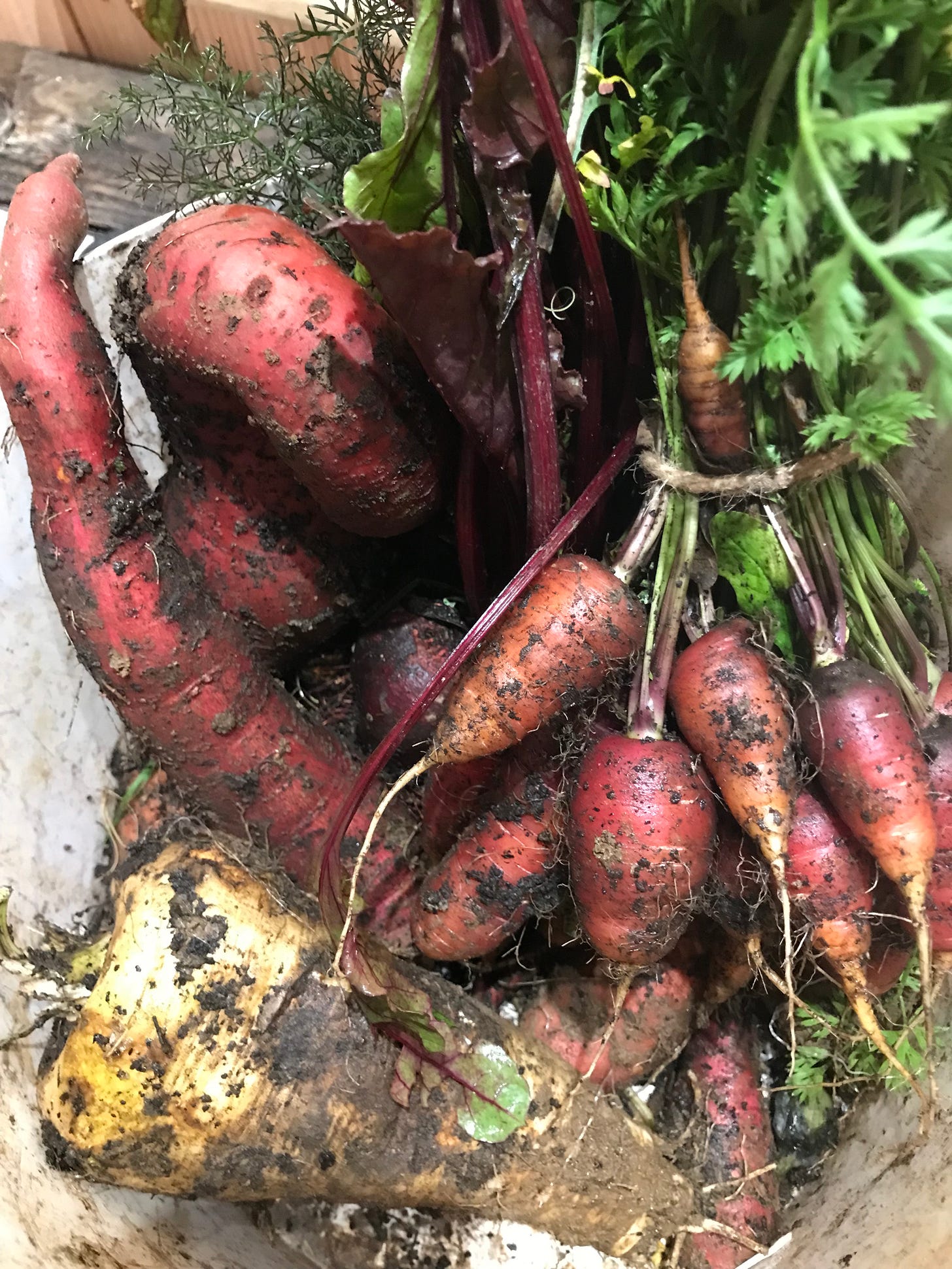Hello again, my friends. Thank you for joining me, and I’d love it if you joined in the conversation with comments, below. Next time I intend to introduce some of the practical approaches we’re employing here (and the dilemmas and challenges) as we’re learning to belong to and tend this land in a way that causes as little harm as possible.
Weathering
The wind’s back, wild and bumptious. As I approach the ridge road with its 4 turbines a handful of rooks and jackdaws has succumbed to a swift scoot backwards. The sky is dark enough for the single gull to look pure white; no, it’s an egret, making a little headway, legs stretched out behind it like a swimmer. One or two ox-eye daisies nod frantically on the verges, and a whole flock of leaves spins past me.
The same spotty cow has escaped onto the lush verge from her field. The farmer is behind her, and she nips smartly back over the electric fence, which always droops and is probably never switched on. I see the farm has lost the back of its milking parlour to the storms.
Ahead the Monts d’Arrée are swallowed by cloud; to my left the Montagnes Noires are just visible. North, I can almost see to the Channel coast. In town, the lake is chopped by a storm of waves, and the Rivière d’Argent pouring over the lip and into the Chaos in the Forest is as tumultuous and bronze as I’ve ever seen it. I’m glad; the drought took the levels right down this summer. (The photo above is the beginning of the Chaos, but a different day – hence the lake’s tranquillity.)
The swans seem to have sought safer quarters.
Some market-traders are absent, too: Franck the drummer with his goat and sheep cheeses, which I buy still for TM who’s veggie but not vegan, and Mark the Cornish Pasty, who does a very tasty vegan one as well as his other veggie ones. Our friends the young organic market gardeners who met on a tall ship and now live in a yurt in a beautiful valley nearby have a stall full of tempting produce – or it would be if we weren’t harvesting so much right now ourselves. They tell me they lost the poly from their tunnels, but at least not the frames.
Around us all still is much damage – electricity and water have only recently been switched on again for many of our friends and neighbours – and many oaks have lost their crowns, on our land too. Needless to say it’ll be a while before we have internet and phone again – this comes to you courtesy of a friend’s connection. (Update: orange.fr have lent us a dongle till January, so we’re online again.)
I’ve just been up into my beloved forest. The devastation is shocking. Huge tree after tree after tree uprooted, torn, smashed; phone cables – also new, also fibre optic – in an even worse state than ours; telegraph poles snapped in two. Sky where there used to be forest. As bad as the storms at the end of the last century that brought trees in the middle down; here it’s mainly at the edges.
Not that kind of good life
When I’ve mentioned to people our move to France, I believe many picture The Good Life: lots of aperitifs in the sun (golden stone, red roofs etc etc), relaxing in pavement cafés, eating on the terrace, etc. The truth here is that we are incredibly busy all the time, and although we did have sun – too much sun – this summer and last, otherwise it’s often pretty wet, and wet, and wet. Brittany after all is not truly French, but a granite-and-slate Celtic land and, in common with the other Brythonic Celtic edge-dwelling peoples we see a lot of rain; quite familiar to me from my lifelong dwelling in the Westcountry. Trouble is, it’s not so tempting to get outside and do what has to be done in a Force 8 with vertical rain like broom-handles punctuated with horizontal sheets.
That soup
I’ve been collecting chestnuts and parasol mushrooms for as long as I can remember. When I was growing up, the wonderful wild Morte Point on the North Devon Atlantic coast boasted a forest of parasols. Later, living in a campervan on the Atlantic coast of France with my then husband and our small daughter one autumn and winter, we foraged for a great deal of our food, and drying slices of parasol mushrooms festooned the van interior. (They’re particularly good crumbled dry into other soups.)
This autumn, the chestnuts in our fields and lanes have been enormous. You might remember from earlier posts how I’ve been cooking and peeling them to freeze most mornings – to the point where I had a chestnut-preparing-meltdown. I can only do about 25 to 30 in an hour, and I’ve resolved not to collect any more. However, they are a great addition to our vegan-protein store.
When Christina and Jerry, whom I mentioned in post 5, were here helping us in October Jerry reminded me of how well mushrooms and chestnuts go together. He told us about his soup of mushrooms, chestnuts and Puy lentils.
My own chestnut soup involves our beans, the Cocos de Paimpol fat butterbean-substitute, rather than lentils. In honour of Jerry Smith I add to my usual ingredients two good handfuls of mushrooms of any variety.
The simplest version, and a lovely one, is an onion, sautéed, some mushrooms and cooked or bottled chestnuts added to that, then a few butterbeans and some vegan stock; optional extras are nutmeg, fresh thyme, sage, bay leaf. At the end, blitz it then stir in a small carton of plant cream.
I use parasol mushrooms without their stems, but a good substitute would be chestnut or shiitake mushrooms.
NB IMPORTANT: If you do use parasol mushrooms, please be very certain to identify them correctly, and don’t rely on the mushroom identification phone app about which there’s been controversy lately. I accept no responsibility for any foraging mistakes. If in doubt, buy your mushrooms.
This version of the soup, below, includes more ingredients; I love adding celery which goes so well with chestnuts in a soup or a gratin:
FOR 2
1 fat leek, green included
1 clove garlic
200g mushrooms
2 sticks celery
400g chestnuts, peeled & cooked (or a jar or tin): keep some back to break up and scatter on top
generous mug cooked white beans
olive oil
stock to cover
seasoning
(optionals: soy sauce, herbs as above)
Sauté together in the oil the first 4 ingredients.
Add the chestnuts, then the beans.
Stir briefly then cover with the stock and bubble gently for 30–40 minutes.
Blitz it.
Taste and season.
I serve it with plant yogurt (I love the coconut-based one, though I acknowledge there are foodmiles involved) or plant cream, the remaining chestnuts, and nutritional yeast flakes, the ones with added vitamin B12. This is a protein-rich soup.
Back in the market; & that lunch
In Huelgoat market there is an Epicerie Ambulante; that is, a mobile organic wholefood store, with loose produce. I’m queuing up to buy the lentils, rice and buckwheat that form the main protein content of our dogs’ diet (no, it’s not cruelty, and yes I will write of it!) but am just succumbing to some human buckwheat dark chocolate cookies, delicious, when my neighbour in the queue, one of the mayoral assistants from our commune (roughly translated as parish), turns to me.
This little impoverished commune continues to amaze me. I didn’t know till we moved to Finistère quite how many Brits there were in the area – as there were too in the 4th and 5th centuries CE, when ‘we’ were displaced by the Saxons from our edgelands in the southwest of Britain (and some of us, heretics for betraying our own pagan heritage, floated out here on granite stones and the like to convert the pagans to the new Roman religion).
It appears that the Mayor is laying on a free lunch for the many Brits in the commune. Actually, I’m not sure if the woman, C, is saying that all Brits in the area are invited to the lunch, nor whether, if so, it is free for everyone, or only the Ancient Brits; or whether it’s only for those of A Certain Age, and is free for them.
‘No, no, NO,’ says The Man when we get home. ‘NO. What, waste two hours of my life and my smallholding time to converse with a load of random elderly ex-pats with whom I probably won’t have much in common? No.’
Well, I confess to feeling similarly; I tend to keep my mouth shut when I hear an English voice, despite the fact that we have some very good British friends here, as well as a few Bretons and French. Plus all our time feels precious: personally, because of the scale of our project here, and we are no longer ‘spring chickens’ – not even summer ones; but also because of the immense privilege of living in a relatively democratic and certainly safe and tranquil place, rather than a war-zone.
But. I bring out the ‘It would be diplomatic’ card; and mention that it’s quite a thing for the Mayor to put on such an event for local Brits; and how the least we can do is show our support and appreciation. And it’s only two hours, etc etc. I also mention ‘integration’, although TM suggests surely it’s more like ghettoisation if it’s only for ex-pats, and no native residents. I decide not to mention the deplorable fact that it might involve a sing-song.
Eventually my arguments prove persuasive.
We have to sign up by a certain date. We need to go in to the Mayor’s office anyway, as there is still some lack of clarity as to who deals with the dangerous-dangling-branches scenario, not to mention the blocked public right of way between ‘our’ fields. Oh and the little matter of no phone lines, like miles of the rest of the commune.
The Mayor is polite, but clearly expecting complaints. When I mention how much we appreciate the commune having cleared away the trees blocking our exit from the fermette within hours of the hurricane, he looks taken aback and then bursts into a huge smile. ‘That makes a change from all the criticism I’ve been receiving!’
I say we are also there to accept the invitation to lunch. There is a ‘but’ – ‘We are vegetarians.’ I can’t say I’m vegan because the meat-with-every-meal French barely relate to vegetarianism, let alone food without dairy, etc.
‘Oh-la-la!’ he exclaims (‘Oo-la-la’ is for women). ‘Let me see: we could offer you a pea and some lettuce...’
‘Could you make it two peas?’ I ask. ‘Each?’
He smiles. ‘We can probably find a carrot or two as well.’
He tries gallantly and very diplomatically to ascertain our ages. I’m still no clearer if it’s only for older people or whether that’s merely the free-lunch sector. Either way, seems we’re in.
More about that lunch when we’ve been.
S/he who cuts, keeps
This morning, early, in a rare fit of sunshine burning through the mist rising from the stream, there’s a tractor and a chainsaw at the top of the chemin, the public right of way. We haven’t quite determined whether it’s our responsibility to clear the trees that are blocking it; we suspect it is, as they have fallen from our banks; but then again maybe the commune shares ownership of the banks. We hope.
We take the dogs out. There are mushrooms everywhere now – sodden parasols and a few large yellow stainers, which I think are quite toxic.
One tree at the very entrance to the chemin has been cleared and logged. The rest are still in situ, still blocking the track.
I go and say hello to the two guys with the tractor, the chainsaw and the pickup. By now they are further up the lane and scratching their heads about the conifer that has fallen diagonally right across the lane from bank to bank. The pickup contains the sawn logs. (The fallen tree is still there, a few days later.)
‘You’re welcome to cut the rest of the trees on the chemin and take the timber,’ they say to us. I don’t know whether that’s a way of letting us know it’s commune property but they won’t mind at all if we do the work, or whether I should say ‘Thank you for letting us cut and collect our own wood’. I do say that we have yet to buy a chainsaw – if any stores still have any, that’s tomorrow’s job for TM. (Update: he did.)
And now, in a patch of not-sun but not-yet-rain, I need to go and bowsaw some more branches, mainly from oak and chestnut that fell in the Home Meadow, dig some sweet potatoes, and plant another few garlic cloves. Just before dark as the birds begin their low-key dusk songs.
This evening’s haul: Evangeline sweet potatoes; the first big parsnip (the two I’ve dug so far have been small and forked); a couple of beets; a bunch of mixed carrots: the lovely rouge-sang, red and orange in a graduated shift, and the local-ish variety of orange carrot, Carantec. I feel a roast veg and ‘cheesy’ chestnut and leek savoury crumble supper coming on.








Hi Roselle, just fortuitously stumbled upon you here through the Substack web of connection. 😊
Yum yum yum. The soup and thought of a savoury crumble had my mouth watering.
I also am a vegetarian. A "vegaquarian" I describe myself as, I do eat a bit of fish. Travelling in Europe was pretty tricky 25 years ago as a vegetarian. I wonder if it is any easier to find more than a pea or a piece of lettuce these days....?
Jo 😊
Lovely work, has me reminiscing about our root vegetable crops in the past - hopefully again in some small measure next season! After a carrot fresh from the farm, store-bought certainly can never compare again :)